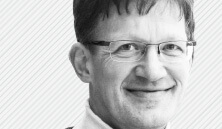Arguably, the field of LC has advanced through the years thanks to a sustained technology push from within its own ranks. The transition from high-performance to ultra-(high-) performance LC, the development of new types of columns (porous-surface particles, monoliths), the emergence of micro- and nanofluidic systems and the advent of comprehensive two-dimensional liquid chromatography amply demonstrate the point. At HPLC2013, technology push is represented by the “HYPERformance LC” theme. The speakers in this parallel line of the program have been affectionately classified as “hardcore liquid chromatographers” or “HPLC nerds.”
Thanks to the successful development of the technique, LC helps answer a myriad of questions in science and society. In return, demands from many different application areas should help LC move forward. One of the areas that has benefited greatly from demands from outside the community is the combination of LC with mass spectrometry (LC-MS), which is the second major theme of HPLC2013. LC-MS proved quite difficult in the previous century, but it was eventually developed successfully to meet great needs in life science, food science and environmental science. MS in itself is experiencing a significant technology push towards higher resolution, greater sensitivity and better multi-stage (MSn) possibilities.
The third theme of HPLC2013, High-Impact LC, embodies the market-pull mechanism. Our ambition is to outline a strategic agenda for the development of LC in the next decade.
"Our ambition is to outline a strategic agenda for the development of LC in the next decade."

For this purpose, leading scientists from seven fields (environmental, food, forensic, metabolomics, pharmaceutical, polymers, proteomics) will identify needs in their respective domains that may be met with the aid of LC. These challenges will provide a fresh perspective to the HPLC community. Each "challenger" is followed by an LC expert who is active within the same domain. These “responders” will summarize what is already possible with LC. The framework is completed by five submitted oral presentations on specific aspects of, for example, sample preparation, analysis, detection, and interpretation within the application domain. After the seven lectures, the moderator of the session will lead a discussion to draw conclusions and formulate specific targets for the HPLC community.
One potential weakness of the approach is that application domains other than the seven highlighted areas will be underexposed. These include important questions from life science, such as the study of nucleic molecules, lipidomics and glycomics. The growing biotechnology and biopharmaceutical industries also demand attention from liquid chromatographers. In part, these will be addressed within other areas (for example, biopharmaceuticals within pharmaceuticals, lipids within metabolomics). And, by dividing the applications into small-molecule LC-MS and large-molecule LC-MS, few analytes can escape our comprehensive coverage.
Liquid chromatography still offers fantastic opportunities for separating complex non-volatile mixtures. And this will long be the case if we can ensure that HPLC remains relevant and contributes significantly to the efficiency of scientific research and industrial development and, ultimately, to safer, healthier and more enjoyable lives for all.
Results from the seven sessions will contribute to a first draft of a strategic agenda that will be briefly presented in the final plenary session of the meeting and published with the symposium proceedings. Eventually, the agenda may serve as a framework for the program of future HPLC meetings.
These High-Impact LC sessions will help all of us in the field. Challengers and responders will wrestle with major unmet needs of the market, and catalyse insights from every delegate into the analytical mission of the next decade. Let the games begin!
HPLC2013, the 39th International Symposium on High-Performance-Liquid-Phase Separations and Related Techniques, takes place in Amsterdam, June 16-20.




